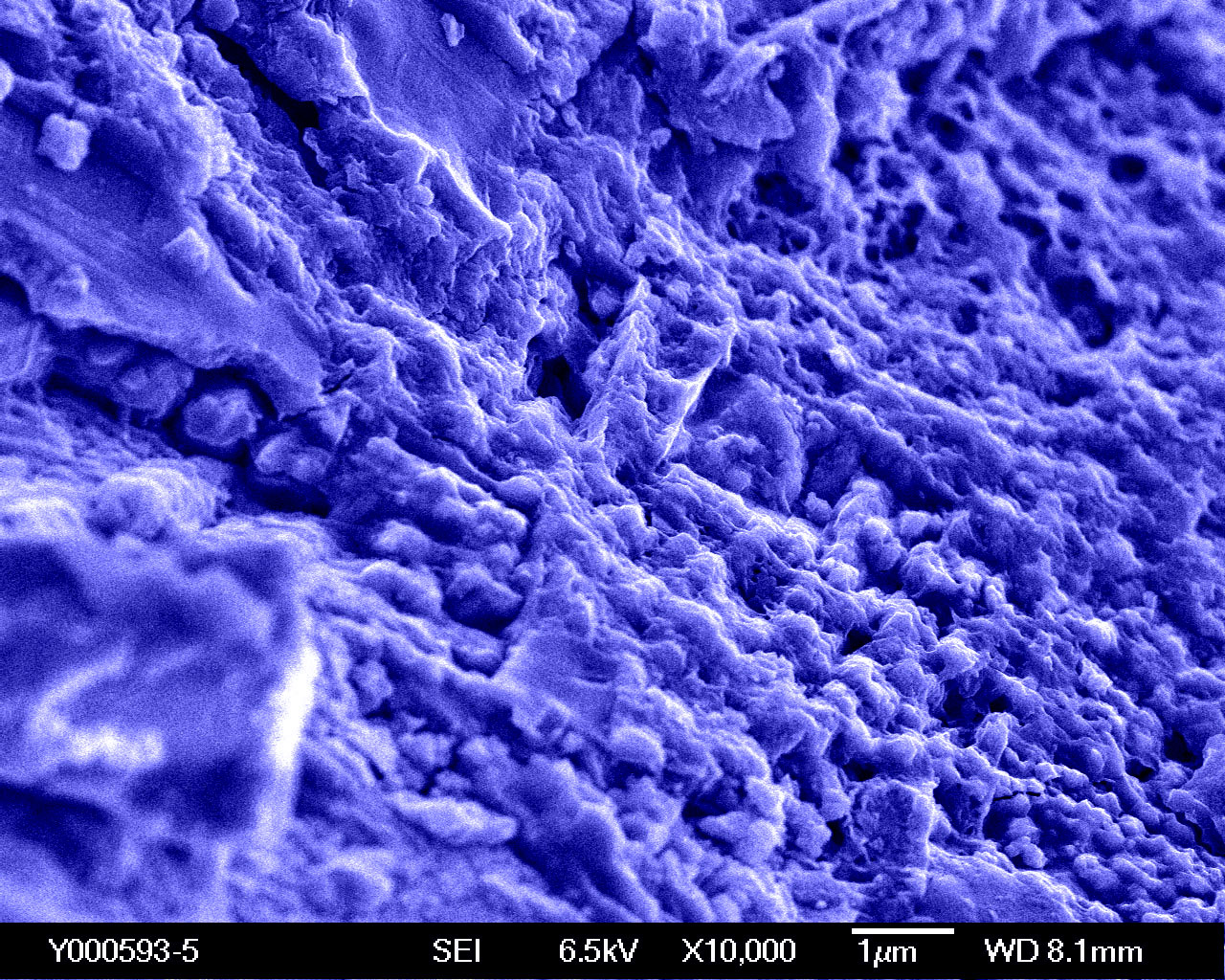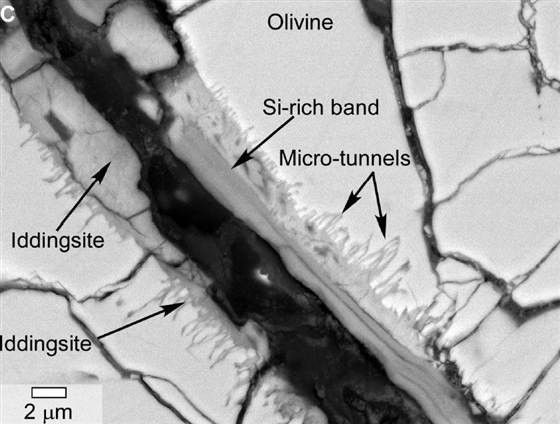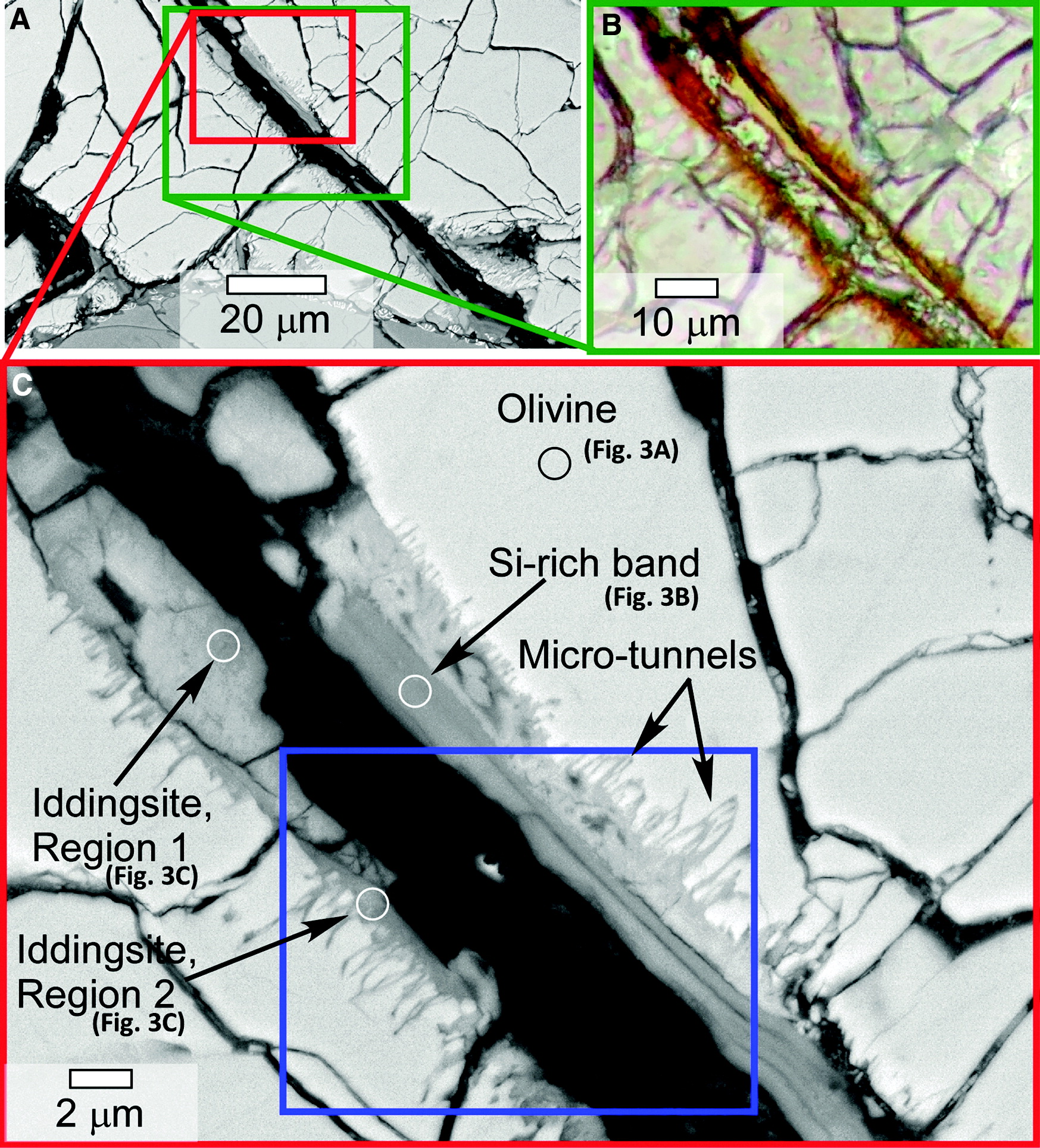It looks like you're using an Ad Blocker.
Please white-list or disable AboveTopSecret.com in your ad-blocking tool.
Thank you.
Some features of ATS will be disabled while you continue to use an ad-blocker.
share:
I'm still slogging through the paper. If you're serious about doing the same, PM me with a email address. Apparently the pix are still under
copyright and NASA itself hasn't decided to flaunt the results. It took almost three years of juried arguments to get the paper approved for
publication.
reply to post by JimOberg
Yes, NASA might feel like it was burned in that major televised announcement in the mid-1990s of possible life-hints in a meteorite (I remember watching it in a college commons room, and enjoying the restrained enthusiasm on the screen). It's interesting this one has already been vetted for three years, and now goes to the wider community for more vetting. I'd love to read the entire paper with understanding, but my knowledge of the terms used is too limited for me to get much out of it, maybe others will take you up on your offer and can give us other viewpoints. thanks again for the thread!
Yes, NASA might feel like it was burned in that major televised announcement in the mid-1990s of possible life-hints in a meteorite (I remember watching it in a college commons room, and enjoying the restrained enthusiasm on the screen). It's interesting this one has already been vetted for three years, and now goes to the wider community for more vetting. I'd love to read the entire paper with understanding, but my knowledge of the terms used is too limited for me to get much out of it, maybe others will take you up on your offer and can give us other viewpoints. thanks again for the thread!
edit on 24-2-2014 by Aleister because: (no reason given)
reply to post by JimOberg
So this in part is thought to be some kind of Algae/Algae, the fossils of which have been in the meteorite, which itself has been a resident of Antarctica for 50,00 years. Have I got that bit right?
Y000593 is down the page a bit in this NASA PDF from...I'm not sure!
ntrs.nasa.gov...
So this in part is thought to be some kind of Algae/Algae, the fossils of which have been in the meteorite, which itself has been a resident of Antarctica for 50,00 years. Have I got that bit right?
Y000593 is down the page a bit in this NASA PDF from...I'm not sure!
ntrs.nasa.gov...
edit on 24-2-2014 by smurfy because: Link.
JimOberg
I'm still slogging through the paper. If you're serious about doing the same, PM me with a email address. Apparently the pix are still under copyright and NASA itself hasn't decided to flaunt the results. It took almost three years of juried arguments to get the paper approved for publication.
As well they should be. No doubt they are desiring bigtime to make such an announcement, but due to what I outlined, there has to be no room for doubt, else what a mess. it would be starting a religion over a scientific understanding.
I suspect that all you will get out of the long paper is a simple researching the possibility of, not a suggesting it definitely is. the clip you quoted summed it up nicely that that's the view.
The link has images of the Yamato 000593 meteorite, externally, as a whole, and thin sections magnified. One also shows the location in Antarctica
where it was found.
www.open.ac.uk...
www.open.ac.uk...
edit on 24-2-2014 by Ross 54 because: corrected
link address
edit on 24-2-2014 by Ross 54 because: corrected link address
Great find, I think the common unferstanding/belief is that Mars once was very capable of supporting life.
It's nice to have some possible hard evidence. Hopefully they can provee definitively that it was life and not some other process.
It's nice to have some possible hard evidence. Hopefully they can provee definitively that it was life and not some other process.
Blue Shift
JimOberg
This paper has just been cleared for publication, and an old, old friend of mine is one of the authors.
The papers disputing this should be interesting to read.
Grabbing popcorn for it.
I've read the paper and it is solid.
You have good friends Jim
Is he going to be involved with the 2020 rover mission? From what I gather, he should be.
edit on 24-2-2014 by JadeStar because: (no reason
given)
Xcathdra
reply to post by JimOberg
FIVE NEW MARS METEORITES FOUND
The link from 2002 details the discovery, with some analysis, of the meteorite in question. From your source:
The finding of nakhlites in Antarctica is for the first time and it suggests that the Yamato meteorite field potentially includes more unique meteorites. We describe the analytical results of the meteorite.
Field Occurrence: About 60 % of Y000593 is covered with black fusion crust, and the interior is greenish colored. Several days after the finding the quite similar specimen (Y000749 of 1.3 kg) was found. It is suggested that it is a paired specimen with Y000593. Two meteorites locate on a bare ice field of the north of JAREIV nunataks, and the area had insufficiently searched only by JARE-20. In the area, the heaviest meteorite in the Yamato bare ice field has been also found by the same expedition of JARE-41.
Has any of the same kind of analysis been done of Y000593's paired meteorite, looking for the same material or chemistry? I'm assuming by "paired" they mean that the other meteorite and the one which has been studied and reported on in this thread are from the same incoming object.
edit
on 25-2-2014 by Aleister because: (no reason given)
edit on 25-2-2014 by Aleister because: (no reason given)
edit on
25-2-2014 by Aleister because: (no reason given)
JimOberg
I'm still slogging through the paper. If you're serious about doing the same, PM me with a email address. Apparently the pix are still under copyright and NASA itself hasn't decided to flaunt the results. It took almost three years of juried arguments to get the paper approved for publication.
Well try this for an image:
meteorite image
reply to post by sy.gunson
better than nothing , but the information about what we are seeing is scanty, a slice of the meteorite under an electron microscope is about all I got from the wiki (summation of all knowledge hmmm)

cool pic tho ,so I added a little colour for contrast
funBox
better than nothing , but the information about what we are seeing is scanty, a slice of the meteorite under an electron microscope is about all I got from the wiki (summation of all knowledge hmmm)

cool pic tho ,so I added a little colour for contrast
funBox
The paper, and the data to which it refers, were reportedly vetted for three years before publication. That represents a great deal of work and
attention. We may, it seems, assume that a high degree of importance has already been ascribed to these findings. It could be that the accumulated
weight of evidence for Martian fossils in meteorites has finally reached the tipping point. Perhaps the balance of scientific opinion will now shift
from rejection to acceptance.
It is apparently believed that the famous Nakhla meteorite contains very similar features to Yamato. This suggests the possibility that it and several other meteorites will now be found to have as good evidence for fossils, and that other, previous claims of the finding of minute fossils in meteorites will be accorded greater attention.
It is apparently believed that the famous Nakhla meteorite contains very similar features to Yamato. This suggests the possibility that it and several other meteorites will now be found to have as good evidence for fossils, and that other, previous claims of the finding of minute fossils in meteorites will be accorded greater attention.
reply to post by JimOberg
Damn!
How many other decades to admit the existence of life on Mars?
Damn! I'm not so Young!
Apparently the pix are still under copyright and NASA itself hasn't decided to flaunt the results. It took almost three years of juried arguments to get the paper approved for publication.
Damn!
How many other decades to admit the existence of life on Mars?
Damn! I'm not so Young!
The entire paper now available online, free. It appears that considerable care was taken to make the case that the fossil-like features are not likely
to be due to geological/mineralogical factors, alone.
One receives the impression that if such structures were found in ordinary Earth rocks, they would be classed as fossils, without much ado. The similarity of the relevant features in the Yamato and Nakhla meteorites, despite the fact that the latter has been on Earth a much shorter time, seems to argue against terrestrial contamination.
online.liebertpub.com...
One receives the impression that if such structures were found in ordinary Earth rocks, they would be classed as fossils, without much ado. The similarity of the relevant features in the Yamato and Nakhla meteorites, despite the fact that the latter has been on Earth a much shorter time, seems to argue against terrestrial contamination.
online.liebertpub.com...
edit on 25-2-2014 by Ross 54 because: improved paragraph
structure
reply to post by Aleister
Replying to myself, but actually to others, has this meteorites companion (see post linked) been tested as well for the same signs of life/structures? Apparently the two of them are from the same meteor, so testing the second one with the same processes may (or may not) show similar results.
This is getting quite interesting. Said it once or twice, but thanks to Jim Oberg for bringing this here.
Replying to myself, but actually to others, has this meteorites companion (see post linked) been tested as well for the same signs of life/structures? Apparently the two of them are from the same meteor, so testing the second one with the same processes may (or may not) show similar results.
This is getting quite interesting. Said it once or twice, but thanks to Jim Oberg for bringing this here.
Here's the story we just broke at NBC:
Tiny Blobs and Tunnels in Meteorite Revive Debate Over Life on Mars
www.nbcnews.com...
Tiny Blobs and Tunnels in Meteorite Revive Debate Over Life on Mars
www.nbcnews.com...
We know from bacteriology that organisms on the micrometer scale often assume one of three shapes. Spiral, tube, or sphere. It's interesting that the
same areas in the meteor that are enriched in carbon, relative to the rest of the rock, a possible sign of once-living things, assume two of these
three shapes.
Further, we're told that the minute tubes are undulating in form, something like the course of a river. This is said to be characteristic of micro-fossils on Earth.
When a number of coincidences begin to pile up like this, it should generally be taken to mean something. Here it seems to mean the remains of once living things. The only serious obstacle to this interpretation appears to be that these particular things very probably come from the planet Mars.
Further, we're told that the minute tubes are undulating in form, something like the course of a river. This is said to be characteristic of micro-fossils on Earth.
When a number of coincidences begin to pile up like this, it should generally be taken to mean something. Here it seems to mean the remains of once living things. The only serious obstacle to this interpretation appears to be that these particular things very probably come from the planet Mars.
JimOberg
Here's the story we just broke at NBC:
Tiny Blobs and Tunnels in Meteorite Revive Debate Over Life on Mars
www.nbcnews.com...
From your source. Are those tunnels where the little critters would have fed?

reply to post by Aleister
ahh at last some more news ,there's a couple of links from the news source that you can get more info and bigger pictures
link from nbc
further diagrams and annotations can be found down the page
from the site :


funBox
ahh at last some more news ,there's a couple of links from the news source that you can get more info and bigger pictures
link from nbc
further diagrams and annotations can be found down the page
from the site :


funBox
reply to post by funbox
In the words of Ben Bova when he first saw a close up of a Mars landscape, "Looks like Jersey".
In the words of Ben Bova when he first saw a close up of a Mars landscape, "Looks like Jersey".
edit on 25-2-2014 by Aleister because: (no
reason given)
edit on 25-2-2014 by Aleister because: (no reason given)
new topics
-
In an Historic First, In N Out Burger Permanently Closes a Location
Mainstream News: 44 minutes ago -
MH370 Again....
Disaster Conspiracies: 1 hours ago -
Are you ready for the return of Jesus Christ? Have you been cleansed by His blood?
Religion, Faith, And Theology: 3 hours ago -
Chronological time line of open source information
History: 4 hours ago -
A man of the people
Diseases and Pandemics: 6 hours ago -
Ramblings on DNA, blood, and Spirit.
Philosophy and Metaphysics: 6 hours ago -
4 plans of US elites to defeat Russia
New World Order: 7 hours ago -
Thousands Of Young Ukrainian Men Trying To Flee The Country To Avoid Conscription And The War
Other Current Events: 11 hours ago
top topics
-
Israeli Missile Strikes in Iran, Explosions in Syria + Iraq
World War Three: 14 hours ago, 17 flags -
In an Historic First, In N Out Burger Permanently Closes a Location
Mainstream News: 44 minutes ago, 8 flags -
Thousands Of Young Ukrainian Men Trying To Flee The Country To Avoid Conscription And The War
Other Current Events: 11 hours ago, 7 flags -
Iran launches Retalliation Strike 4.18.24
World War Three: 14 hours ago, 6 flags -
12 jurors selected in Trump criminal trial
US Political Madness: 14 hours ago, 4 flags -
4 plans of US elites to defeat Russia
New World Order: 7 hours ago, 4 flags -
A man of the people
Diseases and Pandemics: 6 hours ago, 3 flags -
Chronological time line of open source information
History: 4 hours ago, 2 flags -
Are you ready for the return of Jesus Christ? Have you been cleansed by His blood?
Religion, Faith, And Theology: 3 hours ago, 1 flags -
MH370 Again....
Disaster Conspiracies: 1 hours ago, 1 flags
active topics
-
MH370 Again....
Disaster Conspiracies • 3 • : Cvastar -
In an Historic First, In N Out Burger Permanently Closes a Location
Mainstream News • 1 • : DAVID64 -
12 jurors selected in Trump criminal trial
US Political Madness • 43 • : RazorV66 -
Are you ready for the return of Jesus Christ? Have you been cleansed by His blood?
Religion, Faith, And Theology • 12 • : visitedbythem -
Post A Funny (T&C Friendly) Pic Part IV: The LOL awakens!
General Chit Chat • 7125 • : imitator -
I Guess Cloud Seeding Works
Fragile Earth • 28 • : Degradation33 -
AARO/Dr Kirkpatrick-Caught Lying in UAP report.
Aliens and UFOs • 26 • : baablacksheep1 -
Thousands Of Young Ukrainian Men Trying To Flee The Country To Avoid Conscription And The War
Other Current Events • 21 • : Consvoli -
Not Aliens but a Nazi Occult Inspired and then Science Rendered Design.
Aliens and UFOs • 15 • : anthelion -
-@TH3WH17ERABB17- -Q- ---TIME TO SHOW THE WORLD--- -Part- --44--
Dissecting Disinformation • 540 • : IndieA
